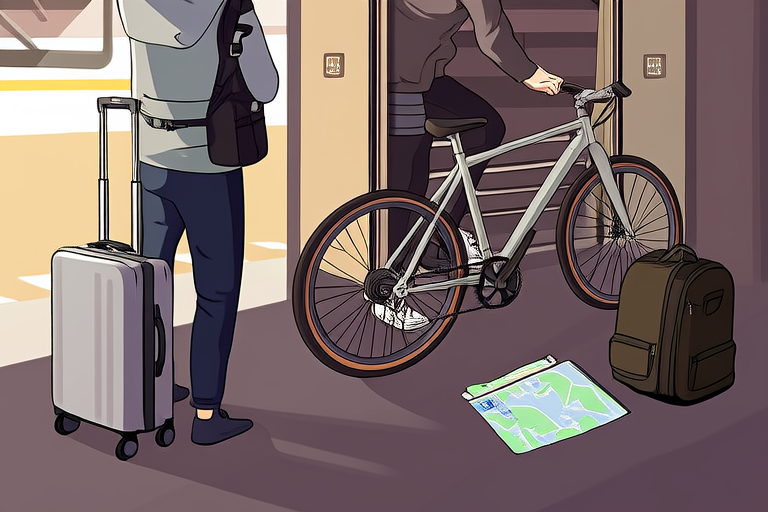Introduction: The Importance of Safe and Efficient Cycling Overseas
Cycling abroad is an exhilarating way to explore new cities, landscapes, and cultures. However, it comes with its own set of challenges, especially when it comes to transportation. Whether you’re planning a short weekend trip or a long-term cycling adventure, understanding the local traffic rules, bike maintenance, and safety precautions can make all the difference. This guide will provide you with essential tips to ensure your biking experience abroad is both enjoyable and hassle-free.
Understanding Local Traffic Rules and Regulations
One of the first things you need to do before embarking on your cycling adventure abroad is to familiarize yourself with the local traffic laws. Each country has its own set of regulations that may differ significantly from what you’re used to at home. For example, in some countries, cyclists are required to ride on the left side of the road, while in others, they must stay on the right.
Research Before You Go
Before your trip, spend some time researching the traffic rules specific to your destination. Websites like Google Maps and local government transportation departments can be invaluable resources. Look for information on bike lanes, speed limits, and any specific rules for cyclists. Additionally, consider downloading a mobile app that provides real-time traffic updates and alerts for cyclists.
Adapting to New Environments
Once you arrive, take some time to observe how local cyclists interact with traffic. Notice where they stop, which routes they prefer, and how they navigate through intersections. This observational learning can help you adapt quickly and avoid common mistakes.
Essential Bike Maintenance for Travelers
Maintaining your bicycle is crucial for ensuring a smooth and safe journey. Traveling with a well-maintained bike can prevent unexpected breakdowns and keep your trip on track.
Pre-Trip Checklists
Before you leave, perform a thorough check on your bike:
- Tires: Ensure they are properly inflated and free of any cuts or punctures.
- Brakes: Test the brakes to make sure they are responsive and functioning correctly.
- Chain and Gears: Lubricate the chain and ensure the gears shift smoothly.
- Lights and Reflectors: If you plan to cycle in low-light conditions, make sure your lights and reflectors are working.
On-the-Go Maintenance
While traveling, it’s important to carry a basic toolkit. Include items such as a multi-tool, spare tubes, tire levers, and a pump. Learn how to change a flat tire and adjust minor issues like loose bolts or squeaky brakes. Many hostels and bike shops offer repair services, but being self-sufficient can save you time and money.
Safety Measures for Cyclists Abroad
Safety should always be your top priority when cycling in unfamiliar environments. From wearing appropriate gear to understanding the risks, here’s how to stay safe while enjoying your ride.
Protective Gear
Always wear a helmet, even if it’s not legally required. A properly fitted helmet can significantly reduce the risk of head injuries. Additionally, consider wearing reflective clothing, especially if you plan to cycle during early morning or late evening hours. Reflective vests and ankle bands can increase your visibility to drivers.
Defensive Cycling
In many foreign cities, drivers may not be accustomed to sharing the road with cyclists. Practice defensive cycling by staying alert and anticipating potential hazards. Keep a safe distance from vehicles, use hand signals when turning, and be mindful of pedestrians and other cyclists.
Emergency Preparedness
It’s wise to carry a small emergency kit that includes items like a whistle, bandages, and a basic first aid kit. Familiarize yourself with local emergency numbers and know where the nearest hospital or clinic is located.
Practical Case Study: Cycling Through Europe
Let’s take a look at a practical example of cycling through Europe, one of the most popular destinations for cyclists. Europe offers a diverse range of cycling routes, from scenic coastal paths to challenging mountain trails.
Route Planning
When planning your route, consider using apps like Komoot or Strava, which provide detailed maps and user-generated route suggestions. These tools allow you to filter routes based on difficulty, terrain, and scenery. Make sure to check weather forecasts and avoid areas prone to heavy rainfall or extreme temperatures.
Accommodation Options
Finding suitable accommodation for cyclists can be a challenge. Look for hostels, hotels, or campsites that cater specifically to cyclists. Many places offer secure bike storage and showers, making it easier to freshen up after a long day of riding. Websites like Bike Hotel and Cycle Route Planner can help you find cyclist-friendly accommodations.
Conclusion: Embrace Your Adventure with Confidence
By following these critical transportation tips, you can confidently embrace your cycling adventure abroad. Remember, preparation is key to a successful trip. Take the time to research, maintain your bike, and prioritize safety. Whether you’re exploring the winding roads of Italy or the picturesque countryside of France, your cycling experience will be enriched by a little bit of knowledge and foresight.
Actionable Steps:
- Research local traffic laws before your trip.
- Prepare a pre-trip checklist for your bike.
- Wear protective gear and practice defensive cycling.
- Plan your route carefully and choose cyclist-friendly accommodations.
Happy cycling!
